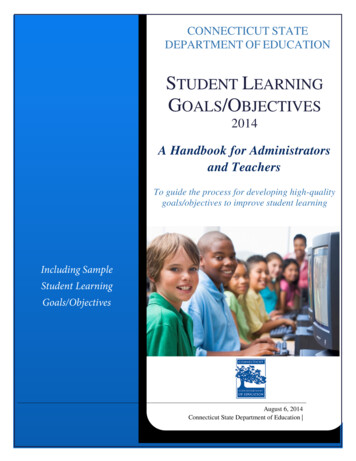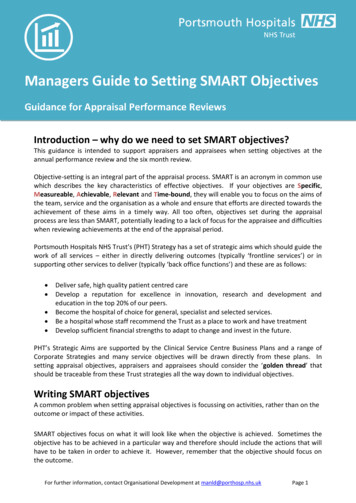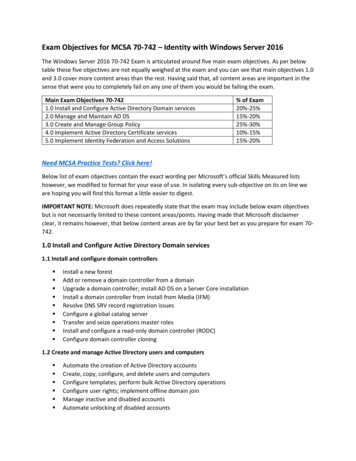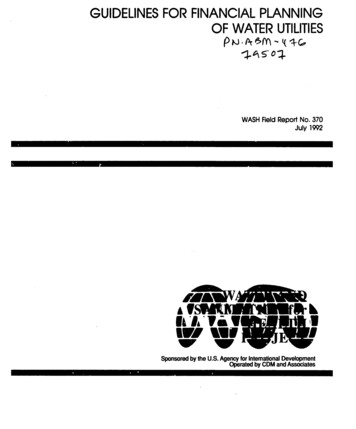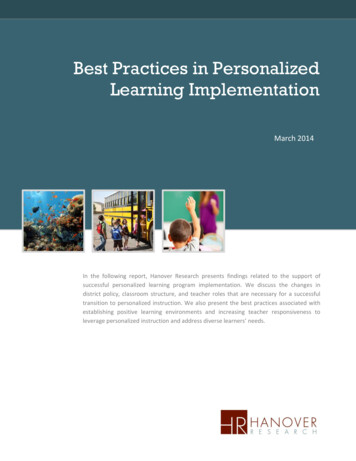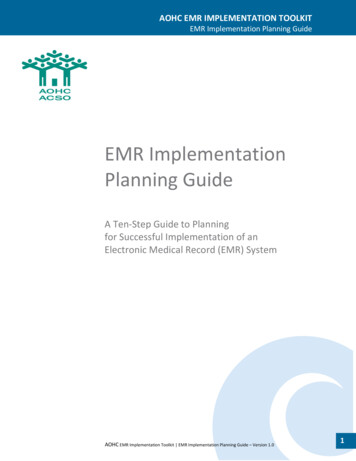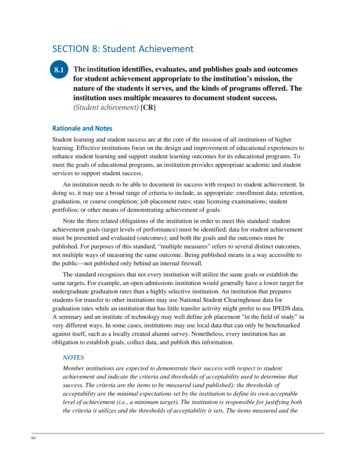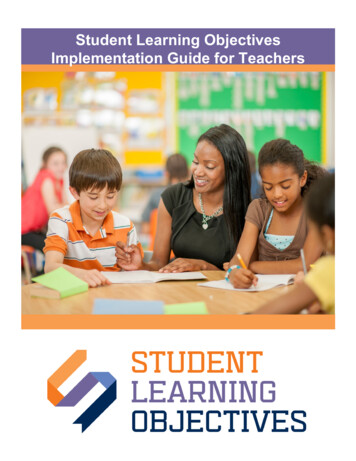
Transcription
This document contains both information and form fields. To read information, use the Down Arrow from a form field.Student Learning ObjectivesImplementation Guide for Teachers
Table of ContentsUsing This SLO Handbook . 2The Texas Student Learning Objective Process. 4Question 1: What is the focus for my SLO? . 5Question 2: Who are my students?. 10Question 3: What are my expectations for these students? . 15Question 4: How will I guide these students toward growth? . 21Phase 2: Monitor Progress to Drive Instruction . 24Question 5: Are my students progressing toward targets? . 24Phase 3: Evaluate Success and Reflect . 27Question 6: Did students grow, and what did I learn from the process? . 27Final Thoughts: Student Learning Objectives . 30Appendix A: SLO Form . 31Appendix B: Student Growth Tracker . 35Appendix C: Rating Rubric . 36Appendix D: Success Criteria. 38Appendix E: Progress Discussion Notes (Optional) . 39Appendix F: End-of-Year Reflection . 40Appendix G: Definitions for the SLO Process . 41 TEA7/30/2021SLO Teacher GuideTable of Contents1
Using This SLO HandbookThe purpose of this Implementation Guide is to provide step-by-step information about crafting,implementing, and reflecting on SLOs. This guidance is not designed as a stand-alone resource forSLO implementation but should accompany training on the SLO process and support throughout theyear. Teachers will be able to find support on a particular step by locating the general question in thetable of contents and jumping to that section of the guide.Vision StatementThe Student Learning Objective (SLO) Model in Texas provides a framework for continualdialogue among students, teachers, and principals to support student growth and teacherdevelopment throughout the year.Guiding Principles Support Local Autonomy: Provide flexibility for districts, campuses, and classrooms toadapt as needed.Support and measure Student GrowthSupport Teacher Development:Provide a meaningful framework for measuring student growth and supporting teacherdevelopmentDesign Attributes TEAInstructionally Valuable: Support educators to make responsive instructionaldecisions throughout the year.Standards-Aligned: Address academic standards that are critical to student learning.Equitable: Meet the unique needs of all students and teachers.Transparent: Be clear, concise, and easily understood.Manageable: Be easily incorporated into and enhance existing methods formeasuring student learning.7/30/2021SLO Teacher GuideUsing This SLO Handbook2
What Are Student Learning Objectives?Excellent teachers regularly set learning goals for their students and use a variety of data sources tomonitor progress towards these goals throughout the year. The Student Learning Objectives processaims to capture this best practice as a means to allowing teachers and teacher appraisers to determinestudent growth and reflect on a teacher’s pedagogical strengths and areas for growth.Student Learning Objectives are: Student growth goals Set by teachers Focused on a foundational student skill that is developed throughout the curriculum Tailored to the context of individual students Designed to help teachers better understand the impact of their pedagogy For the purposes of measuring student growth and refining a teacher’s instructionWhy Use Student Learning Objectives (SLOs) as a Measure of Student Growth?SLOs drive both teacher practice and student learning by strengthening instruction. The use of SLOshas been associated with improved student outcomes on standardized assessments. Teachers craftingSLOs report improved understanding of how to use data to determine student needs and to measureprogress toward growth goals. SLOs encourage collaboration among teachers as well as betweenteachers and their appraisers. SLOs encourage the adoption of a long-term vision for student learningand contribute to more meaningful discussions about vertical planning. Finally, SLOs provide aframework for measuring student growth grounded in student work as the source of evidence TEA7/30/2021SLO Teacher GuideUsing This SLO Handbook3
The Texas Student Learning Objective ProcessProcess Overview and Planning ConsiderationsThe Student Learning Objective process should be used throughout the school year to help teachersplan backward from an end vision for student success. This process helps encourage regularconversations and collaboration among teachers, students, and appraisers in order to ensure thatinstruction facilitates students’ progress toward targeted growth goals.The SLO process represents a continuous cycle of improvementembodied in strong teaching practice. Teachers and their appraiserswill use SLOs to design strategies to meet their goals for studentsuccess, beginning with planning and leading to thoughtful instructionaldesign and delivery. Throughout the year, teachers will collect a BOE(body of evidence) of student learning and adjust instructionaccordingly. At the end of the cycle, teachers will reflect on outcomesand plan to refine their practice for the following year.For ease of understanding, the SLO process has been grouped intothree key phases to define the sequence of actions to be taken.Phase 1: Creating a Student Learning ObjectiveThe first phase focuses on purposeful planning of instruction and setting student growth goals.At the beginning of the course, teachers work with each other, their appraisers, and othersupport staff to identify the foundational skill they’ll address in their SLO, identify studentstarting points on the foundational skill, and develop clear targets for student growth.Phase 2: Monitoring Progress to Drive InstructionAfter the SLO Form is completed and approved by the appraiser, teachers will work with eachother and their appraiser, engaging in ongoing dialogue about progress toward goals.In this phase, teachers work with each other and their appraiser,to discuss students’ progress toward goals. These discussionsare opportunities for teachers to develop strategies to adjustinstruction based on analysis of student learning. Teachers designassignments/projects/assessments that will constitute the body ofevidence of student work.Phase 3: Evaluating Success and ReflectionThis last phase occurs at the end of the course and involves usingthe body of evidence of student work to determine whetherstudents met their growth goals. It also includes a conversationbetween the teacher and appraiser regarding the effectiveness ofthe teacher’s engagement in the SLO process, and results in anoverall rating that is based on both teacher and student outcomes.The final conversation helps teachers and appraisers plan forinstructional refinement. TEA7/30/2021SLO Teacher GuideThe Texas Student Learning Objective Process4
Phase 1: Create a Student Learning ObjectivePhase 1 will occur over the first 1-2 months of school for yearlongcourses, or in the first 3-4 weeks for semester courses. DuringPhase 1, teachers will work with other teachers and with theirappraiser to develop Student Learning Objective(s) for a selectedcourse.Although teachers will use the Student Learning Objective formto craft the SLO, the form simply captures the thinking prompted bythe first four overarching questions found on the SLO Thinking Map(see p. #). Following the guidance below, teachers will spend timegathering resources and information to complete Steps 1 through 5.To improve the quality of the SLO, teachers may wish to refer tothe SLO Success Criteria.Step 1: What is the focus of my SLO and what is my SLO SkillStatement?The goal of this step is to identify a foundational skill for this course that would be an appropriatefocus for the SLO, and lead to an effective Skill Statement. Foundational skills: .Are the most important skills students develop in the course.Can impact not just this course but other courses both in this current year and beyond.Persist throughout the course.Will be found in multiple TEKS.The Skill Statement represents a balance between being valuable for teacher growth, student growth, andbeing important for students both in the current course and in other courses beyond this year. If there aremultiple, competing skills that appear to be equally important, teachers should consider which of thosefoundational skills they feel will lead to improving their instruction the most.Decide on a general content area for focusThe process for selecting an area of focus is different for the first year of SLO implementation than forthe following years.For the first year of implementation, teachers should focus on learning the SLO process. If teacherscan work in teams in a common content area or with content with which they’ve had success in thepast, they should consider taking that opportunity.SLO Teacher Guide TEA7/30/2021Step 1: What is the focus for my SLO?5
Best PracticesFor each year after the first year of implementation, teachers should focus ona content area that provides the greatest opportunity to improve studentgrowth and the teacher’s instructional practices. The primary goal ofappraisal and SLOs within an appraisal system is to help identify a teacher’sareas of strength and areas for refinement. SLOs function best when used tofacilitate student and teacher growth and development.Begin the process by reviewing the courses or content areas that you teach.What you are looking for is a general content area to review further. If you are an elementary generalist, determine what content area youmight choose. Should it be ELAR, math, science, or social studies? If you are a secondary teacher with multiple course preparations,consider a particular course for your focus. If you are a teacher of special education or of English languagelearners, could you collaborate with classroom teachers on a similarfocus area? Open a dialogue with colleagues to determine if you canjoin the team to develop an appropriate SLO Skill Statement. Develop yourSLO SkillStatement withcolleagues. Share commonelements of the SLOSkill Statement withyour colleagues, buteach teacher willcraft and submit hisor her own SLObased on currentstudents. Use data tonarrow the focusof your SLO SkillStatement. Where appropriate,initiate verticalplanningconversations withthe teachers of thegrades and coursesbeyond yours torefine yourselection of “musthaves” for thecourse.What should you consider in this deliberation? Is one content area moreworthy of focus due in order to meet students' needs?What is the most important content of my course?The next step is to identify foundational skills associated with the selectedcontent area. Teachers may be able to make these selections based on theirknowledge of what components of the class were key elements in thesuccess of previous classes. Educators should collaborate with their peers inthis selection process. This will be especially important for new teachers whodo not have the historical basis for this selection. Keep in mind: The focus area should be designed to address foundational skills thatare pivotal to the current course as well as students’ subsequenteducation.Hint: Consider the question: When students leave my course,what is the one thing they must be able to do as they moveforward in their education? Foundational skills should be threaded throughout the term of thecourse. These should not be unit-based selections; rather, they arebroad skills that are addressed multiple times in lessons and, moreimportantly, are applied by students throughout the course.SLO Teacher Guide TEA7/30/2021Step 1: What is the focus for my SLO?6
Teachers’ Thinking Revealed“This is my 10th year of teaching art in high school. And although we have four key areas weaddress in the introductory class, the principles and elements of art are the foundation. Oncestudents understand that content, they can begin to express it in their creative work and use it incritiques of others’ works. So that is going to be the focus for my SLO.”“Our fifth grade team met and basically decided right away to do an ELAR SLO. Our studentshave done well in math for several years, so we feel confident that our planning for math works.But, once we got to thinking about foundational skills in ELAR, we could not agree where to focus.Two team members thought we should work on reading and two thought writing was moreimportant. So, we looked at the 4th grade STAAR results for ELAR and writing. Clearly, writingoutcomes were lower and particularly low in the composition reporting category. And the sixthgrade team also reported that writing to a prompt was a weakness in many of our students forstudents who were coming into our fifth grade class this year. We also noticed that early studentwork from these students supported this as a weakness as well. So, we decided to focus thereand found that the 5.15 and 5.18, which address writing process and expository writing work.”In middle school social studies, we are just beginning to have students work on in depth researchprojects. This has always been a challenge for my students not because they can’t write, butbecause they have difficulties understanding what they read, especially when it comes fromprimary sources and context plays a role in understanding. We have seen that reading ofinformational texts is an ongoing weakness for students in our school, based on STAAR results. Ifeel comfortable that this the right choice for a focus in our SLO.”Find TEKS that align with the selected contentNow that you have specified a particular focus, and written a Skill Statement, the next task will beto review the TEKS to determine which key standards are aligned to the focus.To find your TEKS, visit this website :http://tea.texas.gov/curriculum/teks/Remember that the introductory paragraphs often identify key skills and content areas for thecourse.As you review, consider the following: In some disciplines, process standards may be more applicable than content standards.For example, a high school social studies class will address a significant number ofstandards addressing major events in history. Standards attached to each of those eventswill vary in content, depth, and emphasis. Social studies skills, such as using primary andsecondary sources to develop an argument supported with evidence from the literature,however, can be applied across eras and across content areas. In mathematics, consider using the word “concept” as a strategy for identifying appropriateTEKS. For example, number sense is a concept that moves through multiple strands of studentlearning. It is possible that an SLO could result in asking students to display their grasp of theconcept through different kinds of problems over the term of the SLO. Measurement of thestandards will be required. Consider whether you will be able to assess students’ skill levelsin this content at each stage of SLO process. Measures used as a part of the body of evidence(BOE) must be aligned with the Skill Statement.SLO Teacher Guide TEA7/30/2021Step 1: What is the focus for my SLO?7
Write an SLO Skill StatementSkill Statements represent a valid focus area of the course and are designed to measure foundational skills. ASkill Statement describes specific measurable skills within the selected focus area that persists throughout thecourse and that will lead to student growth within the focus area as well as teacher growth in teaching this skill.For example, suppose a high school US history teacher is consideringappropriate content for an SLO Skill Statement. A variety of topicsexamined throughout the year, such as the American Revolution, theCivil War, the Great Depression, and so on. If the teacher decided tofocus on one event in US history, that topic might be covered for only afew weeks within the school year. In contrast, focusing on interpretinginformation from multiple sources to draw valid conclusions is a skill thatis addressed throughout the course regardless of the historical eventcurrently being studied. Students’ ability to analyze multiple pieces ofevidence to justify their conclusions is critical skill for student success inUS history and other several courses.Using the focus area as a guide, consider a specific, measurable skillthat will result in student growth within the focus area.Focus AreaPrinciples and Elements of ArtSkill StatementStudents will use the elements and principals of design tocreate individual drawings that apply the five key principalsof observational drawing: a) lines, b) spaces and shapes,c) relationships, d) lighting and shading, and e)composition.Expository WritingStudents will apply the steps of the writing process (plan,draft, edit, publish) to craft well organized essays oninformational texts.Using primary and secondarysources from informational textsStudents will be able to use at least two primary orsecondary sources to write an informative essay thatconveys information clearly and accurately througheffective selection of information, organization andanalysis of content.SLO Teacher Guide TEA7/30/2021Step 1: What is the focus for my SLO?8
Complete the SLO FormThe SLO Form, Step 1provides a space for teachers to describe their chosen focus area, share theirSkill Statement, share the rationale for why they selected this particular area and the associatedfoundational skills, and list to the applicable TEKS.Sample SLO Form for Step 1 (based on the 5th grade teacher’s response above)SLO Teacher Guide TEA7/30/2021Step 1: What is the focus for my SLO?9
Step 2: Who are my students?The goal of this step is to describe students’ typical skill level when they arrive in your course. You willdescribe the full range of students who come into your course from the highest- to the lowestperforming skill levels, with respect to the SLO Skill Statement. Next, if you teach multiple classes, youwill select a class for the focus of your SLO. Then, you will collect multiple sources of data about yourcurrent students to decide which description best describes the skill level of each student covered inthe SLO. Finally, you will record the initial skill level for each student. Think of this as an answer to thequestion that you are often asked, “What kind of students do you have this year?” For the foundationalskill selected for the SLO Skill Statement, you are establishing whether this year’s class is a typicalgroup in terms of entering skill levels, a higher performing group, or a lower performing group.Describe the typical entering skill levels of students in your classPicture the typical skill level of your students. How would you describe their entering skill levelassociated with your SLO Skill Statement? Write that description in the middle block of the chartcalled the Initial Skill Profile. Next, think about the highest-performing students and describe theirentering skills in the top box. Next, think about the lowest-performing students and describe theirentering skill level in the bottom box. Then, fill in the gaps just above and just below typical skill levels.What you will see is something that looks like a rubric to assess students’ entry level skills. The goalis to make these descriptions crisp and distinct. Later, you will need to be able to pick a descriptionthat best fits each student in your class.Hint: What was just described is one strategy to complete the profile. Some teachers will statethat it was easier for them to start with the highest-performing skill level and work their way downthrough the other levels. Find a strategy that works for you.There are a couple of key elements to remember. First, this is not based on your current students. Thatmay seem odd, but the goal here is to try to understand if this class is similar to your previous classes,or if it’s higher or lower performing. This will impact instruction and how you complete your SLO.Second, make sure there is no overlap between the levels. For example, here are a couple of ISPlevels from a high school automotive mechanics instructor:Well Above Typical Skill states: Students understand the basic principles behind how engineswork and have some experience rebuilding engines.Above Typical Skill states: Students understand the basic principles behind how engines workand have some experience rebuilding engines with guidance.At first glance, they are different, but in practice, would you be able to distinguish one level from theother? Chances are a high school student would not have occasion to work on an engine without someform of supervision. In practical terms, it would be hard to differentiate between the two. TEA7/30/2021SLO Teacher GuideStep 2: Who are my students?10
Another potential issue in Initial Skill Profiles is using words such as “most,” “many,” and “some” in thedescriptions. Ask friends to describe the difference in meaning between “most,” and “many.” Some willtell you percentages, and if they do, the percentages may not match. Others will have a specificdefinition in mind. The point is that there is ambiguity in these words. This does not mean that theycannot be used; rather, it means that they need to be defined. For example, you could include a legendat the bottom of the profile explaining the meaning of these ambiguous words as you will use them.One last thing to remember is that you want to be able to describe the full range of student performancethat you are likely to see. Try to make sure that every student can be mapped to a description. Forexample, as you create the description for “Well Above Typical Skill”, consider some of the mostadvanced students you have ever taught. We will discuss later what happens if you discover that youhave a student(s) who doesn’t fit into the levels you created for your Initial Skill Profile.What if you have never taught this course or you are new to teaching? Consult your colleagues whomay have taught the course before to determine what they have noticed with students in the past. Inaddition, you may need to review data on earlier student performance to determine appropriatedescriptions. One other strategy could be used in cases where you have vertically aligned courses. Inthose cases, the end-of-year expectations as indicated in the TEKS might be helpful to describe whatstudents should be able to do upon arrival in your course.Finally, check with your colleagues. Review each other’s’ Initial Skill Profiles to check for clarity.Sometimes a fresh set of eyes will notice wording difficulties that you may not have noticed. A sampleInitial Skill Profile is below for a fourth-grade teacher focusing on critical thinking and problem solving inscience:Initial Student Skill ProfileSkill LevelDescriptorsWellabovetypical skillStudent selects and uses tools, materials, and questions to investigate the naturalworld, following methods prescribed by the teachers, and using critical thinking skillsto analyze, evaluate, and report findings.Abovetypical skillStudent selects and uses tools, materials, and questions to investigate the naturalworld, following methods prescribed by the teacher, and uses basic logic to analyzefindings.Typical skillStudent selects and uses tools, materials, and questions to investigate the naturalworld, following methods prescribed by the teacher and uses basic logic to provideexplanations for some observations.Belowtypical skillStudent selects and uses tools, materials, and questions to investigate the naturalworld, following methods prescribed by the teacher, but does not attempt to explainfindings.Well belowtypical skillStudent is unable to select and use tools, materials, and questions to appropriatelyinvestigate the natural world. TEA7/30/2021SLO Teacher GuideStep 2: Who are my students?11
Select the class.When teachers select the class they’ll use for their SLO, the entire class should be included – targetingparticular students or a portion of the class is not permitted. SLOs are designed to help reveal theeffectiveness of teaching practices and to truly inform teacher development. To do this, the processmust focus on the growth of all students in the selected class, not just the growth of a portion of theclass. For elementary generalists, this will be the whole class. For elementary departmentalized teachers or secondary teachers, this will be the mostrepresentative class. Teachers should ask themselves, “Which class best represents thediversity in skill levels and challenges from among other classes I could have selected?” Itwould be best to avoid selecting classes that are unique for a particular reason (i.e., particularlyhigh- or low-performing students).Note: In subsequent years of implementation, this will be modified as follows:Teachers and appraisers will collaborate to determine an area of challenge for the teacher.This might be a content area that is new to the teacher or in which the teacher wants toexpand his or her mastery of the material. It might be a course where guiding students tomastery has proven to be difficult. The decision on where to focus will be part of theconference in which the goal-setting and professional development plan conversationsoccur (generally in conjunction with the end-of-year conference). It is important to think ofSLOs as part of the appraisal system. Aligning goal-setting, professional development plans,and SLOs will lead to more successful strategies for gaining the support and feedbackneeded to meet the targets established in the SLO.Collect multiple sources of data about students to identify initial skill level.The next task will be to collect multiple sources of data about your current students. It is important toremember that this should be current data, not data from previous years. The goal is to describestudents’ current skill level at the beginning of the course for the skill in question in the SLO. Thesedata can come from both formal and informal sources.For example, formal measures could include: Quizzes.Unit assessments.District formative assessmentsTeacher-created assessments/pre-testsStudent work products including writing samples, lab reports.Less formal measures include exit tickets that ask students to summarize their understanding or askquestions about the content, class work, class participation, etc. Considerable data can be drawn fromyour observations and interactions with students in class. What questions do they ask? Are they basicor more advanced questions? What kinds of errors or misconceptions do you see in homeworkresponses? TEA7/30/2021SLO Teacher GuideStep 2: Who are my students?12
A single source of data is not likely to be conclusive. Students do have “bad” days when they do notexhibit their potential. They may respond better to certain kinds of questions than they do to others.Collecting multiple measures will provide a more complete and accurate understanding of eachstudent’s initial level of understanding and reduce the chance that what you are measuring are justrandom effects.It is also important to remember that this does not need to be a new measure that you create. Newmeasures can be created, especially if current measures do not appropriately assess the skill inquestion, but it is not essential. Effective instruction is in and of itself a data-gathering process.Teachers ask themselves, “Are they getting it? Do I need to adjust what I am doing?” That is data, andit can be an invaluable resource for estimating students’ preexisting level of skills and learning. If youcan use these formal and informal data sources and feel confident about your evaluations of students’skill level, do so, but if questions remain, you may need to consider some additional sources of data.Map current students to the Initial Skill Profile.In the previous section, you determined what data sources you would collect about students’current level of learning. In this section, you will focus on mapping students to the Initial Skill Profileto answer the question, which description is the best fit for each student included in the SLO
SLOs encourage collaboration among teachers as well as between teachers and their appraisers. SLOs encourage the adoption of a long-term vision for student learning . conversations and collaboration among teachers, students, and appraisers in order to ensure that instruction facilitates students' progress toward targeted growth goals.
